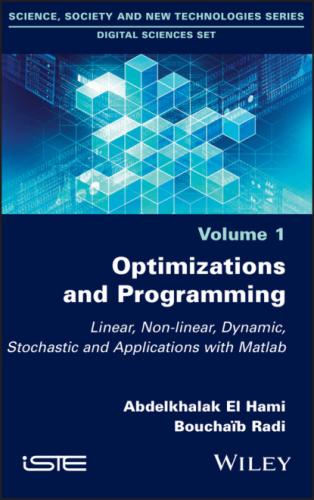As we saw above, the value of z increases from 0 to 8, but there are still negative values in the last row of the tableau, so we need to perform another change of basis by applying the formulas [1.4] and [1.3] after substituting
r = 1, x3 leaves the basis.
The computation with this new basis is presented in Table 1.3.
Table 1.3. Third simplex tableau
The value of z now increases from 8 to
EXAMPLE 1.6.– Consider the linear problem:
[1.8]
Let us introduce slack variables x3, x4 and x5:
[1.9]
This gives the following initial tableau with the basis (x3, x4, x5):
The new basis is (x3, x1, x5) given as:
The next basis is (x2, x1, x5) given as:
Since the reduced costs are all positive, this tableau is optimal. The optimal solution is x1 = 150 and x2 = 100, giving an optimal value of z = −1, 500, 000 for the objective function.
1.5.4. Existence and uniqueness of an optimal solution
After writing out the first simplex tableau and adding zj = −cj to the last row, there are three possible cases:
1) zj − cj ≥ 0 for j = 1, . . . , n. The basic feasible solution x is already optimal. This optimal solution may or may not be unique;
2) there exists j ∈ {1, . . . , n} such that zj −cj < 0 and aij ≤ 0 for every i ∈ J. In this case, the domain of realizable solutions is unbounded and the problem is ill-posed, since max z(x) = +∞;
3) the usual case: there exists j ∈ {1, . . . , n} such that zj − cj < 0, and there exists i ∈ J such that aij > 0. The change in basis described earlier is now possible and should be performed, possibly several times, until case (1) is reached.
Could the simplex algorithm ever fail to terminate if case (3) leads to a loop? The answer is yes, and examples have been successfully constructed. However, they are very rare in practice.
Let us therefore state two important theorems about the simplex method.
THEOREM 1.3.– Let
THEOREM 1.4.– Let
REMARK.– For a comprehensive discussion of the efficiency of the simplex method, refer to [CHV 83].
1.6. Initialization of the simplex algorithm
This section presents two techniques for finding a basic realizable solution to initialize the simplex algorithm: the first is the Big M method, and the second is the Phase I method.
1.6.1. Big M method
Suppose that we wish to solve the LP
where A is an m × n matrix, rank A = m < n.
By adding slack variables (with positive or negative signs), we can always reduce the LP to the form (P) described above, with
Ax = b is replaced by Ax + y = b, y = (y1, y2, . . . , ym)T ∈
The new constraints are not equivalent to the initial constraints. The yi > 0 are penalized by replacing the objective function z(x) with
where M is some very large positive value. We will choose yi = bi, i = 1, . . . , m, as a basic feasible solution to serve as the initial solution.
Since the yi significantly reduce the value of z′, they will disappear from the basis over the course of the simplex algorithm. As they are non-basic variables, their value will be equal to zero, and the LP that is ultimately solved is the same as the program (P).
EXAMPLE 1.7.– Consider the LP
The new program is given as
The first tableau is as follows:
The
